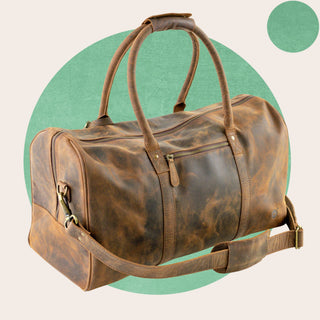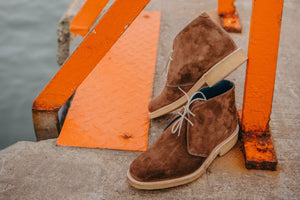Are you a little confused and misplaced as to the differences between these two leather behemoths? If we were to pit Nubuck vs suede, what would the results be? What is suede better for? What about Nubuck?
Well, thankfully we have your back, for today we will be discussing precisely what these two leathers are, their differences and similarities, as well as the pros and cons of each!
What is Suede?
Clearly, there are some differences between suede and nubuck shoes, so let's dive into it.
Suede is a material made by taking the leather cut from the softer and otherwise more pliable lower layers of an animal's hide and then sanding the inner surface. Where the top layer is made up of dense and tightly-packed fibers that constitute a durable and water-resistant surface level, the inner layers are far softer and more vulnerable to the elements.
For this reason, suede shoes are incredibly soft and stylish, not least because the process of producing them alongside suede boots also involves loosening the fibers even further. These fibers are, as a result of this sanding process, raised and provide the leather's surface with a velvety napped finish (even in the case of waxed suede).
Sure, you could say that both suede and nubuck leather has a soft veneer, but which would you say is softer, suede or nubuck shoes?
What is Nubuck?
So, in contrast to suede, nubuck boots will be made from the outer layer of the animal's hide, otherwise known as the full-grain section. Both suede and nubuck will be made of high-quality leather, but unlike suede, this traditional leather of nubuck will be thicker and more durable. This is due to the fact that, as elucidated earlier, the surface layer of leather hide boasts a superior fibrous structure.
After the leather is sanded and given its nappy veneer, it can then be dyed or otherwise treated for a more uniform finish, though these days such an enterprise is often avoided in favor of exhibiting the various character-building imperfections of the leather.
Whether you wear suede or nubuck, chances are that you have chosen either for their velvety texture, but one is more velvety than the other, just as one is stronger and more resistant to the elements than the other.
Benefits
Now, let's see outline the various benefits of each of these products of an animal's skin.
Nubuck
- This leather is incredibly breathable as a result of the splitting process which causes proteins to break down in such a way that means the material is more porous than typical leather.
- In contrast to suede (which itself exhibits a similarly velvety texture), nubuck has a more pronounced nap, providing it with a somewhat rugged aesthetic appeal which will no doubt appeal to some more than others.
- Fashioned from the strongest part of an animal's hide, nubuck is inherently thicker and more robust than suede, making this a better choice for an item of clothing that you are likely to use regularly. Also, unlike suede, nubuck leather will return to its original color once wet.

Suede
- Though both nubuck and suede have a similarly velvety feel, the fact that suede is fashioned from the inner layer of an animal's hide means it is inherently softer and more supple, exhibiting what some would describe as a more luxurious feel.
- For this reason also, suede is typically more pliable than nubuck, bearing a thin and lightweight texture that can then be fashioned into more varieties of accessories and items of clothing than the more robust nubuck.
- Since it is fashioned from the less-desirable lower layer of an animal's hide, suede tends to be slightly less expensive, though this is not always the case.
- Though suede is inherently more susceptible to damage from the elements, it is on the other hand easier to maintain. Often, you will only need to use water and stain repellents to go about protecting suede out in the field.
Disadvantages
As there are pros, there must also be cons...
Nubuck
- As already elucidated above, nubuck leather tends to be more expensive than suede owing largely to the fact that it is fashioned from the altogether more desirable part of the animal's hide, the more robust and durable surface layer. For some, this is a worthy sacrifice.
- Since nubuck leather is inherently stronger, more robust, and, thus, more resistant to the elements than suede, it is also inherently less elastic and, therefore, less pliable and flexible to experimentation. Just try and maneuver some nubuck leather into your own shape and you will know what this means!
- Surprisingly, though nubuck is generally stronger and more durable than suede, it is conversely more susceptible to scratches and other marks. Leather aficionados might be inclined to suggest that such imperfections are what give this leather its signature appearance, though.
Suede
- As already discussed, suede exhibits inherently inferior durability when compared with nubuck. Indeed, though suede is slightly more impervious to scratches and marks than nubuck, the grain structure simply does not support as long a term of durability as nubuck. Suede can still be a robust fabric - especially if it is of considerable quality - but it does not compare with nubuck.
- Likewise owing to the grain structure and the manufacturing process, suede is also more permeable. Though this has been shown to be a benefit in some aspects (especially in terms of breathability and the like), this can also be to its detriment, especially if you are looking to wear the item in more water-logged contexts.
- For similar reasons, suede is more inclined to accrue dirt and dust, thanks to this porous grain structure. For this reason, more specialized cleaning equipment and treatments are required to give it a proper clean.
Cleaning Nubuck Leather
What follows is a loose process for cleaning your modern nubuck leather:
- Instead of using heat to dry nubuck leather, blot it with a microfiber cloth and allow it to properly dry for at least 24 hours in a space away from direct sunlight.
- Preferably using a soft nubuck bristle brush, remove as much dirt as possible by brushing gently in a circular motion, spending not more than a few sections on each section of the item.
- The following day, follow the same motions, brushing the leather in soft, circular motions all over the surface for no more than a few seconds in each sector.
- Once you have properly covered the item, apply a waterproofing product that is specifically for nubuck leather, preferably at least 2-3 times a year. This will be of particular use in colder and wetter months (or climates).

Cleaning Suede Leather
Now, we must learn how to properly clean suede leather:
- Using a dry cloth or microfiber towel, use the same blotting method to remove excess water, being careful to avoid rubbing or wiping the liquid into the suede.
- Now, use a soft-bristled brush or toothbrush to brush the affected fibers back and forth to remove the excess dirt. Ensure that you are not brushing in too much of a circular motion or forcing the nap in various directions. For bonus points, try directing a hair dryer on the lowest setting at the affected area, never allowing the suede to dry on its own.
- The following day, use a soft-bristled brush again to brush the suede back and forth in a similar motion.
- Now you can go about applying a waterproofing product and leather conditioner, similarly around 2-3 times a year as with nubuck leather, especially when the weather is likely to get wetter and colder.
Final Words
So, there you have it! Hopefully, you are now feeling ready and able to head out into the world safe in the knowledge that you know for certain the various differences and similarities between nubuck vs suede leather.
FAQs Nubuck vs Suede
WHAT HAPPENS IF NUBUCK GETS WET?
Not all that much, especially if you have taken the care to apply a strong and worthwhile waterproofing spray. If not - and despite the fact that nubuck leather is considerably more robust than suede - there is still a chance of water damage, especially if you attempt to dry the leather by any other means than blotting.
HOW CAN YOU TELL NUBUCK FROM SUEDE?
The primary difference is in terms of their appearance and texture, though the latter will be a little more difficult to immediately ascertain owing to the fact that both exhibit a similarly velvety texture, at least at first touch. In appearance, nubuck leather will be more napped and more likely to bear various imperfections as a result of the fact that is fashioned from the outer layer of an animal's hide.
IS NUBUCK WATER RESISTANT?
To a degree, yes, though it is always best to apply a generous helping of waterproofing spray specifically designed for use with nubuck leather, though.
WHAT ARE THE CONS OF NUBUCK LEATHER?
The prime cons of nubuck leather have to do with the material's limited breathability (especially in comparison to direct competitor suede), similarly limited scope for pliability (when compared with incredibly supple suede), as well as the relative expense of nubuck due to the fact that it is fashioned from the altogether more desirable outer layer of an animal's hide.
WHAT'S THE MAIN DIFFERENCE BETWEEN SUEDE AND NUBUCK LEATHER?
The main difference between suede and nubuck leather is the part of an animal's hide which each is fashioned from. The former comes from the inner layer of the hide, whereas the latter comes from the outer layer.



